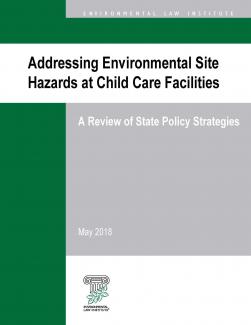Addressing Environmental Site Hazards at Child Care Facilities: A Review of State Policy Strategies

Environmental site hazards at a child care facility may arise from contamination of the air, soil, or water caused by historical uses of the property or nearby activities, which may affect both the outdoor and indoor environment. Identifying and remedying site hazards before a child care facility is licensed and during child care operations is important for limiting harmful exposures to children and staff. Children are especially vulnerable to pollutant exposures because their bodies are developing and because they breathe more air relative to their size than adults. Children’s activities, such as playing on the ground or putting their hands in their mouths, can result in exposures that adults do not face.
This report discusses key policy approaches for addressing environmental site hazards, offers considerations for strengthening existing policies, and highlights examples in New Jersey, New York, and other states.
Overview of the Report
In many states, child care licensing regulations include a general requirement for maintaining the premises free of health and safety hazards. While such provisions could be used to address known environmental site hazards, some states have taken a more proactive approach by establishing the following types of licensing requirements and non-regulatory measures that address potential site hazards directly.
Establish Specific Site/Location Restrictions for New Child Care Facilities. States can adopt child care regulations (and/or accompanying guidance documents) that restrict new child care facilities from locating near specified activities that pose environmental exposure risks or on a site where such activities previously occurred. States could also restrict certain types of polluting businesses from locating near an existing child care facility.
Require License Applicants to Provide Information about Potential Site Hazards. State licensing agencies can request information about potential site hazards from applicants for new child care licenses or license renewals.
Identify Potential Site Hazards During Regular Child Care Facility Inspections. State child care agencies typically require inspections prior to licensing and at specified intervals thereafter. States can incorporate into these regular inspections a review of potential site hazards.
Require Facilities to Assess Potential Site Hazards and Remediate Identified Hazards. States can adopt policies and programs to help ensure that appropriate assessment and remedial actions are taken if a potential site hazard is identified through licensing applications, inspections, inter-agency referrals, or other means.
Provide Technical and Financial Assistance for Providers in Addressing Site Hazards. States can create or expand technical and financial assistance programs to help ensure that child care facilities are able to take the steps necessary to assess and address environmental hazards. Some environmental site hazards may be relatively inexpensive to address, while others may require more extensive remediation activities.
Since publication of the report in 2018, states have continued to develop voluntary property screening initiatives to identify potential site hazards. Delaware is an example of a state that revised its licensing regulations to address site hazards by requiring indoor air testing in certain situations involving potential site contamination.
Visit ELI’s Indoor Environments Program.
© Environmental Law Institute®